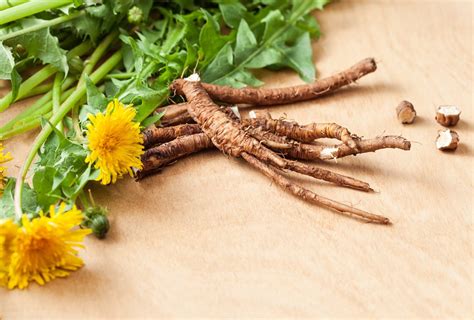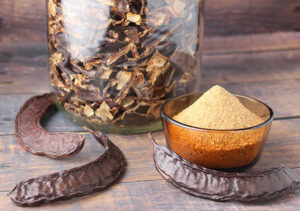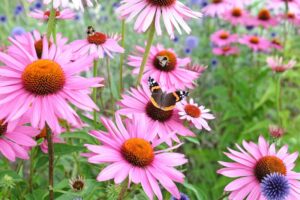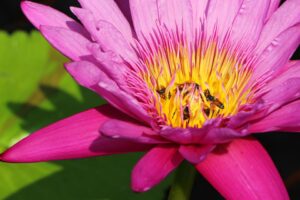Dandelion Root

Dandelion Root, derived from the Taraxacum officinale plant, is a well-known herb in traditional medicine and herbal remedies. While often regarded as a common weed, dandelion is prized for its medicinal properties and nutritional value. The root is particularly valued for its ability to support liver health, aid digestion, and act as a natural diuretic. The plant itself is easily recognizable by its bright yellow flowers and deeply toothed leaves, which give the plant its name.
1. Size:
- Dandelion plants can grow up to 12 to 18 inches (30 to 45 cm) tall. The roots are typically long, thick, and can reach depths of up to 10 to 15 inches (25 to 38 cm) underground.
2. Color:
- Dandelion roots are dark brown on the outside, with a creamy white or pale yellow interior. When dried, the roots may darken slightly.
3. Texture:
- The roots are tough and fibrous when fresh, becoming more brittle as they dry. They have a slightly rough exterior and a firm, woody texture when cut.
4. Fragrance:
- Dandelion Root has an earthy, slightly bitter scent that becomes more pronounced when the root is dried or roasted.
5. Uses:
- Dandelion Root is widely used in herbal medicine to support liver health, improve digestion, and detoxify the body. It is also used to help manage blood sugar levels and reduce inflammation.
- The root acts as a natural diuretic, promoting increased urine production and helping to eliminate excess water and toxins from the body.
- Dandelion Root is known to stimulate appetite and aid digestion, often used to alleviate symptoms of indigestion, bloating, and constipation.
- Roasted Dandelion Root is sometimes used as a caffeine-free coffee substitute. It can also be added to teas, soups, and other dishes for its health benefits and slightly bitter flavor.
6. Habitat:
- Dandelions are incredibly adaptable and can grow in a wide range of environments. They are commonly found in meadows, gardens, and lawns across the world, thriving in full sun and well-drained soil. The plant is hardy and can survive in both temperate and cold climates.
7. Cultural and Spiritual Significance:
- Dandelions are often seen as a symbol of resilience and perseverance, able to grow and thrive in even the most challenging conditions.
- In various cultures, dandelions have been used in folk medicine for centuries. The plant was believed to bring good luck and was often used in rituals to protect against evil spirits.
Spiritual Properties
- Purification: Dandelion Root is used in spiritual practices for purification and cleansing, believed to help clear negative energy and promote healing.
- Manifestation: The root is also associated with manifestation and abundance, often used in rituals to attract prosperity and success.
Medicinal Properties
- Liver Support: Dandelion Root is highly regarded for its ability to support liver function and detoxify the body. It is often used in herbal cleanses and detox programs.
- Anti-inflammatory: The root has anti-inflammatory properties, making it useful in managing conditions like arthritis and other inflammatory disorders.
- Blood Sugar Regulation: Dandelion Root is known to help regulate blood sugar levels, making it beneficial for those managing diabetes or prediabetes.
- Digestive Health: Dandelion Root stimulates the production of bile, aiding in digestion and improving overall gut health. It is commonly used to treat digestive issues like constipation and indigestion.
Allergic Reactions
Dandelion Root is generally considered safe for most people, but some individuals may experience allergic reactions.
- Skin Sensitivity: Handling fresh dandelion plants, including the roots, may cause skin irritation or dermatitis in sensitive individuals. Symptoms may include redness, itching, or rash.
- Cross-Reactivity: People who are allergic to related plants like ragweed, marigolds, or chrysanthemums may also experience allergic reactions to dandelion.
- Interaction with Medications: Dandelion Root may interact with certain medications, particularly diuretics, blood thinners, and diabetes medications. It’s important to consult with a healthcare provider before using dandelion root, especially if you are taking any of these medications.
- Gallbladder Issues: Those with gallstones or other gallbladder conditions should use caution when consuming dandelion root, as it stimulates bile production, which may exacerbate these conditions.
- Gastrointestinal Discomfort: Ingesting large amounts of dandelion root may cause stomach upset, including nausea, diarrhea, or cramping. It’s recommended to start with small doses and gradually increase as tolerated.
- Hypoglycemia: Due to its blood sugar-lowering effects, dandelion root may cause hypoglycemia (low blood sugar) in individuals who are already on blood sugar-lowering medications. Monitoring blood sugar levels is advised when using this herb.

Raw Carob Powder
Raw Carob Powder Raw Carob Powder is derived from the dried pods of the carob tree (Ceratonia siliqua). The pods are ground into a fine,

Damiana Leaf
Damiana Leaf Damiana Leaf is an aromatic herb known for its use in traditional medicine, particularly in Central and South America. It is valued for

Echinacea and its Evolving Role in Cold Treatment
Echinacea and its Evolving Role in Cold Treatment Echinacea, a vibrant purple coneflower, has a rich history in traditional medicine, particularly valued for its immune-boosting

Lotus Stamens
Lotus Stamens Lotus Stamens are the reproductive parts of the lotus flower, known for their delicate structure and unique properties. The lotus is a symbol

Angelica Root
Angelica Root Angelica Root, derived from the Angelica archangelica plant, is a powerful herb that has been used for centuries in traditional medicine and spiritual

Acai Powder
Acai Powder Acai Powder is derived from the acai berry, a small, dark purple fruit native to the Amazon rainforest. This superfood is known for